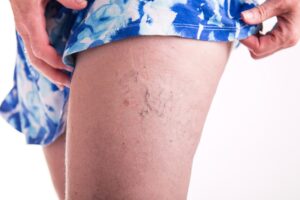Spider Vein Removal
Spider veins are small, thin, dilated veins that lie close to the surface of the skin. Although spider veins do not pose health risks, they can cause significant discomfort, particularly in the legs after prolonged standing. The most common vein problem is spider veins. These broken capillaries, properly named telangiectasias, are small red, blue, or purple web-like veins (less than 2mm in diameter, flat or raised) on the surface of the skin. While not harmful, spider veins are generally felt to be unsightly, and cause some people to be self-conscious.
The primary factors contributing to the development of spider veins include heredity, pregnancy, hormones, weight gain, and prolonged standing or sitting. Spider veins typically occur more frequently in women.
Sclerotherapy Treatment
Over the past few years, the treatment for vein disorders has changed dramatically. New technology has virtually eliminated the need to use surgery for the treatment of surface veins. Non-surgical laser treatments allow for fast, virtually pain-free treatments, requiring minimal recovery time.
Prior to any vein treatments, each patient will receive a thorough medical evaluation to identify the underlying cause(s) of the vein problems. Your doctor will discuss treatment options for your condition, which may include sclerotherapy, laser treatment, or surgery. The best treatment option for you will depend upon the conditions and extent of vein disease, your overall health, risk factors, insurance coverage, and your preference.
Most spider veins are treated with a technique called sclerotherapy. In this office procedure, a tiny needle injects a special chemical medication to seal off damaged veins, detouring the blood to other veins nearby. The veins collapse in response and are reabsorbed by the body, making the surface veins no longer visible. Sclerotherapy relieves symptoms due to varicose veins and spider veins in most patients. You may need anywhere from one to several sclerotherapy sessions for any veins region, depending upon the type and number of veins being treated.
Following sclerotherapy for spider veins, the leg must be supported to allow the vein walls to stick together. This is accomplished by using compression bandages or graduated support stockings. These stockings appear just like tall socks and give no discomfort.
Phases of Treatment
-
1. Level 1 Visit
-
During this visit, an exam is performed to assess the extent of your veins. If you have large or suspicious varicosities, an ultrasound will be scheduled to establish the veins responsible for your condition.
If you appear to only have spider veins, you still might need an ultrasound exam to rule out larger vein involvement. This appointment is used to obtain a complete medical history and thorough examination.
This visit is billed through insurance at contracted rates, or self-pay at $106.
-
2. Sclerotherapy Appointment
-
This appointment is 45 minutes. Sclerotherapy will be performed to treat your spider veins. Spider veins often require more than one appointment to achieve optimal results. Four or five spider vein appointments, scheduled weeks apart, is common, and wearing the compression stockings is key to successfully managing these sometimes pesky veins. Results may vary by patient.
FAQs
-
1. What are spider veins?
-
Spider veins are small red, blue, or purple veins that commonly appear on the surface of the thighs, calves and ankles.
-
2. What causes spider veins?
-
The causes of spider veins are unclear; however, certain factors contribute to the development of spider veins, including heredity, pregnancy, hormonal factors, weight gain, and occupations or activities that require prolonged sitting or standing.
-
3. What is sclerotherapy?
-
Sclerotherapy is a very popular method of eliminating spider veins, in which a solution, called a sclerosing agent, is injected into the veins. This causes an irritation to the inner lining of the vein, resulting in closure of the vein.
-
4. Is sclerotherapy painful?
-
A small gauge needle is used to perform the sclerotherapy injections. Most patients relate the discomfort to an ant bite.
-
5. What happens after the spider vein treatment?
-
Recovery periods may differ from treatment to treatment. Following sclerotherapy, support stockings are worn on each treated leg. Exercise is an important part of the healing process. A 20 minute walk or bike ride twice a day is best for the healing process.
-
6. How long will the results last?
-
You should experience no reoccurrence in the veins that have been treated. Follow-up procedures may be desired to obtain optimal aesthetic results.
-
7. Will my insurance cover the treatment?
-
Check your policy and call your insurance provider to find out what their exact coverage will be.


